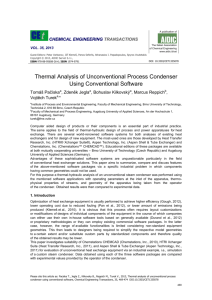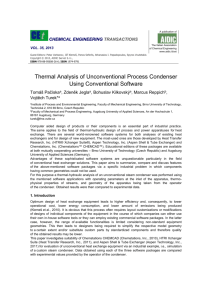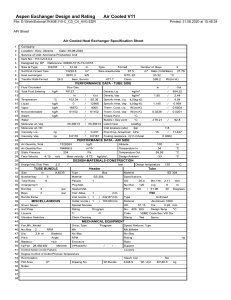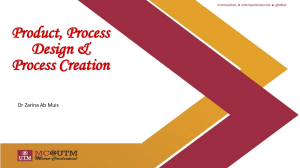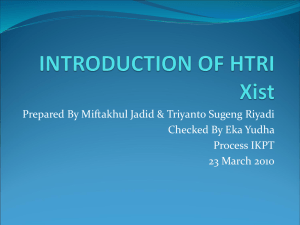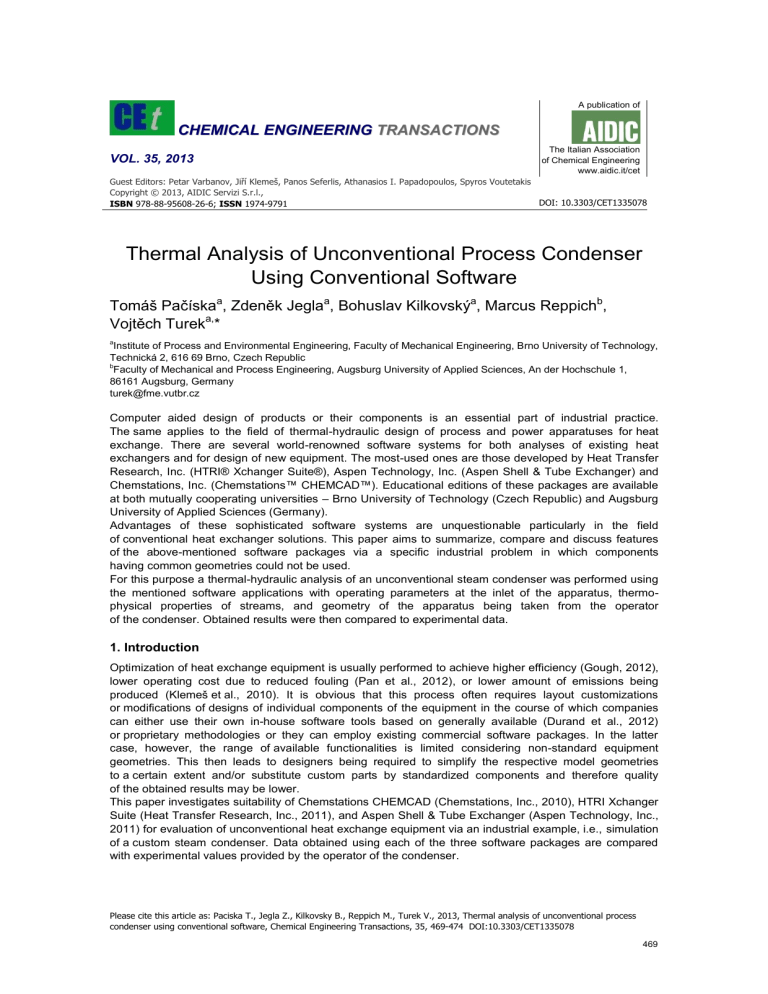
A publication of CHEMICAL ENGINEERING TRANSACTIONS VOL. 35, 2013 The Italian Association of Chemical Engineering www.aidic.it/cet Guest Editors: Petar Varbanov, Jiří Klemeš, Panos Seferlis, Athanasios I. Papadopoulos, Spyros Voutetakis Copyright © 2013, AIDIC Servizi S.r.l., DOI: 10.3303/CET1335078 ISBN 978-88-95608-26-6; ISSN 1974-9791 Thermal Analysis of Unconventional Process Condenser Using Conventional Software Tomáš Pačískaa, Zdeněk Jeglaa, Bohuslav Kilkovskýa, Marcus Reppichb, Vojtěch Tureka,* a Institute of Process and Environmental Engineering, Faculty of Mechanical Engineering, Brno University of Technology, Technická 2, 616 69 Brno, Czech Republic b Faculty of Mechanical and Process Engineering, Augsburg University of Applied Sciences, An der Hochschule 1, 86161 Augsburg, Germany turek@fme.vutbr.cz Computer aided design of products or their components is an essential part of industrial practice. The same applies to the field of thermal-hydraulic design of process and power apparatuses for heat exchange. There are several world-renowned software systems for both analyses of existing heat exchangers and for design of new equipment. The most-used ones are those developed by Heat Transfer Research, Inc. (HTRI® Xchanger Suite®), Aspen Technology, Inc. (Aspen Shell & Tube Exchanger) and Chemstations, Inc. (Chemstations™ CHEMCAD™). Educational editions of these packages are available at both mutually cooperating universities – Brno University of Technology (Czech Republic) and Augsburg University of Applied Sciences (Germany). Advantages of these sophisticated software systems are unquestionable particularly in the field of conventional heat exchanger solutions. This paper aims to summarize, compare and discuss features of the above-mentioned software packages via a specific industrial problem in which components having common geometries could not be used. For this purpose a thermal-hydraulic analysis of an unconventional steam condenser was performed using the mentioned software applications with operating parameters at the inlet of the apparatus, thermophysical properties of streams, and geometry of the apparatus being taken from the operator of the condenser. Obtained results were then compared to experimental data. 1. Introduction Optimization of heat exchange equipment is usually performed to achieve higher efficiency (Gough, 2012), lower operating cost due to reduced fouling (Pan et al., 2012), or lower amount of emissions being produced (Klemeš et al., 2010). It is obvious that this process often requires layout customizations or modifications of designs of individual components of the equipment in the course of which companies can either use their own in-house software tools based on generally available (Durand et al., 2012) or proprietary methodologies or they can employ existing commercial software packages. In the latter case, however, the range of available functionalities is limited considering non-standard equipment geometries. This then leads to designers being required to simplify the respective model geometries to a certain extent and/or substitute custom parts by standardized components and therefore quality of the obtained results may be lower. This paper investigates suitability of Chemstations CHEMCAD (Chemstations, Inc., 2010), HTRI Xchanger Suite (Heat Transfer Research, Inc., 2011), and Aspen Shell & Tube Exchanger (Aspen Technology, Inc., 2011) for evaluation of unconventional heat exchange equipment via an industrial example, i.e., simulation of a custom steam condenser. Data obtained using each of the three software packages are compared with experimental values provided by the operator of the condenser. Please cite this article as: Paciska T., Jegla Z., Kilkovsky B., Reppich M., Turek V., 2013, Thermal analysis of unconventional process condenser using conventional software, Chemical Engineering Transactions, 35, 469-474 DOI:10.3303/CET1335078 469 1.1 Description of the condenser The investigated steam condenser is a horizontal cross-flow shell-and-tube apparatus (see Figure 1). Cooling fluid consisting of 34 % ethylene glycol and 66 % water is fed into tubes of a four-pass tube bundle while steam enters the shell side, where no baffles are present, through an annular distributor to which an inlet nozzle is connected tangentially. There are bonnet-type front and rear heads attached to the shell. Considering operating conditions, these were provided by the operator of the condenser and are specified in Table 1. Figure 1: Scheme of the investigated condenser Table 1: Operating conditions provided by the operator of the condenser Parameter Fluid unit – mass flow rate inlet temperature outlet temperature Pressure vapour mass fraction pressure drop heat duty fouling factor kg/s °C °C kPa – kPa kW 2 m K/W tube side cooling fluid (= cold stream) (34 % ethylene glycol, 66 % water) 113.06 27.0 37.0 400 n/a 56 4,119 -5 7·10 shell side steam, condensate (= hot stream) (100 % water) 1.78 40.3 40.3 7.5 0.96 n/a 4,119 0 2. Methodology To evaluate suitability of the three commonly used commercial software packages (Chemstations CHEMCAD, Aspen Shell & Tube Exchanger, HTRI Xchanger Suite), a thermal-hydraulic simulation was performed and obtained results were then compared with data provided by the operator of the condenser. In other words, the observed differences between obtained data (heat duty and outlet temperature, pressure, and vapour mass fraction) and data from the operator were the principal markers of suitability of each individual software package. 3. Results This section discusses specifics of the aforementioned software packages as well as the obtained data. Also, comparisons of the individual results with experimental values provided by the operator of the condenser are performed and reasons for differences between the two data sets are given whenever possible. 3.1 Evaluation in Chemstations CHEMCAD Chemstations CHEMCAD (see Figure 2) is a universal simulation software package which can be used to evaluate entire processes, their parts, or individual apparatuses. The package contains an integrated module CC-THERM for design and rating in case of both single-phase and two-phase applications, however, only the common types of heat exchangers are supported. Definition of geometry is therefore limited to the selection of standardized shell type, shell orientation (horizontal/vertical), front and read heads, tube bundle, and baffle system. One cannot fully adjust locations of the inlet and outlet nozzles or specify arrangement of individual tube passes. In this particular case it was even impossible to leave out 470 Figure 2: User interface of Chemstations CHEMCAD the baffles due to the lack of a model for non-sensible flow in such a shell. That is, if the evaluated apparatus differs from the standardized TEMA designs in any way, CHEMCAD will probably not be able to incorporate the actual design into its models. Considering the investigated condenser, we would need far wider a set of functionalities than CHEMCAD offers at the moment, including e.g. the possibility to specify eccentric placement of the tube bundle, presence of the annular distributor, etc. Since the CC-THERM module is integrated into CHEMCAD, before opening the module one must first create a flow sheet (even if there is only one apparatus) and carry out basic heat and mass balances. On the other hand, such an approach makes it possible to evaluate processes holistically. There are about forty customizable models available for calculation of K-values. In case of the unconventional condenser in question, the NRTL model was chosen. As for enthalpy, the default LATENT HEAT method was selected. Since thermo-physical properties of process streams cannot be customized in CHEMCAD, properties calculated using the internal database were used. Data obtained by evaluating the condenser in Chemstations CHEMCAD are shown in Table 2 alongside data provided by the operator of the actual apparatus. It is obvious that the obtained outlet temperatures and pressures are fairly similar to the experimental data. Hot stream pressure drop cannot be compared because it was not provided by the operator of the apparatus. The difference in heat duty, however, is quite large which might be related to the fact that steam is not entirely condensed at the outlet (vapour mass fraction is greater than zero). Table 2: Data obtained using Chemstations CHEMCAD Parameter Temperature Temperature vapour mass fraction vapour mass fraction pressure drop pressure drop heat duty stream cold hot cold hot cold hot – unit °C °C – – kPa kPa kW Chemstations CHEMCAD 36.2 39.2 0 0.11 53.82 0.38 3,671 Operator 37.0 40.3 n/a 0 56 n/a 4,119 It should also be noted that the above results were influenced by a number of simplifications necessary due to the very limited ability of CHEMCAD to incorporate the rather unusual condenser geometry into its model. These include e.g. presence of baffles or absence of the annular distributor. With this in mind, it seems that similarity of the data provided by CHEMCAD and the experimental data is rather a coincidence than a consequence of quality of the utilized model. 471 3.2 Evaluation in HTRI Xchanger Suite HTRI Xchanger Suite (see Figure 3) is a very sophisticated and intuitive software package intended exclusively for design and analysis of heat exchange equipment. The implemented algorithms make use of research-supported models which have been validated experimentally. Even though this package is tailored mainly for conventional apparatuses, geometry can be customized to a great extent, which was very useful in case of this particular unconventional condenser. Specifically, it was possible to model the annular distributor and eccentric placement of the tube bundle. Figure 3: User interface of HTRI Xchanger Suite Considering tube bundle eccentricity, one can shift the bundle either vertically or horizontally, but not in both directions at the same time. Nevertheless, since Xchanger Suite requires an annular distributor to be defined separately for the inlet nozzle and for the outlet nozzle (each time via three parameters – length, clearance, and slot area; see Figure 4), it was possible to model the tube bundle eccentricity fully by properly setting the parameter “clearance” for both halves of the distributor. Other functionalities such as definition of placement of each nozzle and arrangement of tube bundle passes, or omission of a baffle system are a matter of course in Xchanger Suite. One can even specify in detail the arrangement of tubes in individual quadrants of the bundle. In addition, unlike in Chemstations Figure 4: Specification of geometry of an annular distributor in HTRI Xchanger Suite; “slot area”, which must also be provided, is the sum of areas of all slots in the respective half of the distributor (Heat Transfer Research, Inc., 2011) 472 CHEMCAD it was possible to provide custom thermo-physical properties of the media. The only downside of using HTRI Xchanger Suite was the fact that tangential connection of the inlet nozzle to the annular distributor could not be modelled. Data obtained by evaluating the condenser are shown in Table 3. As can be seen, the results are generally in very good agreement with the experimental data provided by the operator of the condenser. The value of hot stream pressure drop provided by Xchanger Suite is by an order of magnitude smaller than the value provided by Chemstations CHEMCAD (0.38 kPa, see Table 2). This is due to the ability of Xchanger Suite to take into account both the annular distributor and steam flow towards the centre of the tube bundle. Cold stream pressure drop yielded by Xchanger Suite, by contrast, is larger compared to the experimentally obtained pressure drop or the value obtained using Chemstations CHEMCAD. Table 3: Data obtained using HTRI Xchanger Suite Parameter Temperature Temperature vapour mass fraction vapour mass fraction pressure drop pressure drop heat duty stream cold hot cold hot cold hot – unit °C °C – – kPa kPa kW HTRI Xchanger Suite 37.1 40.7 0 0 62.74 0.03 4,149 Operator 37.0 40.3 n/a 0 56 n/a 4,119 3.3 Evaluation in Aspen Shell & Tube Exchanger Aspen Shell & Tube Exchanger (see Figure 5) is a part of a suite of packages called Aspen Plus. It can either be called as necessary by Aspen Plus from which it takes input data and to which it then returns the results for further processing, or it can be used separately from the suite. Although the former approach can be likened to the way Chemstations CHEMCAD and its module CC-THERM are interlinked, in reality Shell & Tube Exchanger’s usage philosophy is very similar to HTRI Xchanger Suite’s. Compared to the product of HTRI, however, one cannot specify the geometry (placement and orientation of nozzles, arrangement of tube bundle passes, etc.) as easily as in Xchanger Suite. Data obtained by evaluating the condenser in Aspen Shell & Tube Exchanger are shown in Table 4. Temperatures are close to the values yielded by Chemstations CHEMCAD. Pressures, on the other hand, differ quite considerably (both pressure drops obtained using Shell & Tube Exchanger are larger). Considering heat duty, however, it is far below the results provided by the other software packages and also below the experimental value. Inspection of warning messages offered a possible explanation – Figure 5: User interface of Aspen Shell & Tube Exchanger 473 “The specified or implied heat load is above the maximum plausible value. It has been scaled by 0.6956517, to give this value as a first estimate for the Simulation calculation.” Apparently, Shell & Tube Exchanger had markedly lowered the initial estimate of heat duty which in the end caused the model to return a significantly lower value (obviously, in this case steam is not fully condensed at the outlet of the apparatus). We are not sure why this happened because none of the other packages displayed any warning message of this sort or provided such a low value of heat duty. Table 4: Data obtained using Aspen Shell & Tube Exchanger Parameter Temperature Temperature vapour mass fraction vapour mass fraction pressure drop pressure drop heat duty stream cold hot cold hot cold hot – unit °C °C – – kPa kPa kW Aspen Shell & Tube Exchanger 35.5 36.5 0 0.35 59.55 1.39 2,727 Operator 37.0 40.3 n/a 0 56 n/a 4,119 4. Conclusions The presented study was carried out in order to estimate performance and suitability of the available general-purpose simulation software packages should non-standardized geometries be evaluated. Based on the results, it is safe to say that although Chemstations CHEMCAD excels in other areas, it offers little considering evaluation of unconventional heat exchange equipment and therefore is not suitable for such tasks. In other words, this software package can only be used to roughly estimate behaviour of these apparatuses. Aspen Shell & Tube Exchanger performs similarly as Chemstations CHEMCAD. Again, in case of unconventional heat exchange equipment one can only use this package to estimate outlet temperatures, pressures, etc. However, the package offers many functionalities that Chemstations CHEMCAD lacks – e.g. the possibility to specify in detail the arrangement of a tube bundle or placement of each nozzle – and hence its applicability is wider. HTRI Xchanger Suite contains a rather large set of functionalities necessary for evaluation of unconventional heat exchange equipment. Still, this package has its limitations which can pose problems should the apparatus geometry be even more uncommon than in case of the discussed condenser. Nonetheless, suitability of HTRI Xchanger Suite for such tasks is superior compared to the other two packages, which is supported by the results presented in this paper. Considering the current trends in heat transfer enhancement, fouling reduction, and equipment optimization in general, there is a clear need for development of flexible tools capable of evaluating non-standardized geometries. Until such tools are available, CFD or fine-tuned in-house simulation packages tailored for the investigated equipment will yield much better results in terms of accuracy than the general-purpose software packages mentioned in this paper. Acknowledgement The authors gratefully acknowledge financial No. CZ.1.07/2.3.00/20.0020 “Science for practice”. support provided within the research project References Aspen Technology, Inc., 2011, Shell & Tube Getting Started Guide. Nashua, USA: Aspen Technology, Inc. Chemstations, Inc., 2010, CHEMCAD Help. Houston, USA: Chemstations, Inc. Durand, G., Manenti, F., Bandoni, J.A., Diaz, M.S., Buzzi-Ferraris, G., 2012, Performance assessment of existing methodologies for chemical process dynamic simulation. Chemical Engineering Transactions, 29, 241-246. Gough, M.J., 2012, Process heat transfer enhancement to upgrade performance, throughput and reduced energy use. Chemical Engineering Transactions, 29, 1-6. Heat Transfer Research, Inc., 2011, HTRI Xchanger Suite Help. College Station, USA: Heat Transfer Research, Inc. Klemeš, J.J., Varbanov, P.S., Pierucci, S., Huisingh, D., 2010, Minimising emissions and energy wastage by improved industrial processes and integration of renewable energy. Journal of Cleaner Production, 18(9), 843-847. Pan, M., Bulatov, I. and Smith, R. (2012) Retrofit procedure for intensifying heat transfer in heat exchanger networks prone to fouling deposition. Chemical Engineering Transactions, 29, 1423-1428. 474
